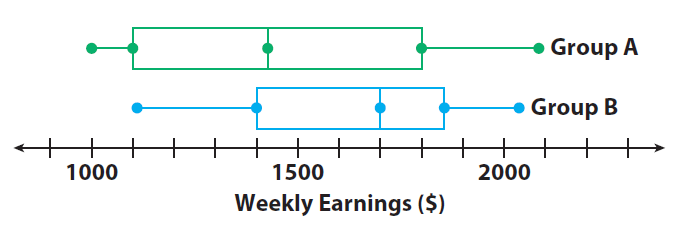

The interquartile range is not part of this five-number summary, but is useful alongside it as a measure of dispersion or spread. interquartile range 50 of all the data point are within this range. Data that is more than 1.5 times the value of. As previously noted, many quantile estimators have been proposed, so there are many ways in which the interquartile range might be estimated. Interquartile range Q3 Q1 In the above example, the lower quartile is 52 and the upper quartile is 58. The population interquartile range is the difference between the 0.75 and 0.25 quantiles, it plays a role when dealing with a variety of problems to be described. It is the difference between the upper quartile and the lower quartile. This information can then be presented in a box plot (box and whisker diagram) making it easy to compare with other sets of data. The interquartile range is the range of the middle half of a set of data. The median and lower and upper quartiles, along with the minimum value and the maximum value of the data set, form a five-number summary of descriptive statistics for the data set. The difference between the 75th and 25th percentile is called. The IQR is far more representative of the spread of this data set because it is not affected by extreme values. Three quarters of the values are less than or equal to the 75th percentile. In descriptive statistics, the interquartile range (IQR) is a measure of statistical dispersion, being equal to the difference between the third and first. The smaller the value for the interquartile range, the narrower the central 50\% of data for the data set. The larger the interquartile range, the wider the spread of the central 50\% of data. The interquartile range (IQR) is a descriptive statistic, and measures the variability or spread of the data. Note: the lower quartile is the median of the lower half of the data, the upper quartile is the median of the upper half of the data.įind the interquartile range of the following data. The interquartile range is a measure of variability that does not depend on the number of observations. Interquartile range \bf th percentile as 75\% of the data lies below this value.

If these values represent the number of chapatis eaten in lunch, then 50 is clearly an outlier. The data points which fall below Q1 1.5 IQR or above Q3 + 1.5 IQR are outliers. The approximate data for "Australia" are as follows: 5 minutes, 1 dot 7 minutes, 1 dot 9 minutes, 1 dot 15 minutes, 2 dots 20 minutes, 3 dots 25 minutes, 1 dot 45 minutes, 1 dot.Interquartile range is the difference between the upper quartile (or third quartile) and the lower quartile (or first quartile) in an ordered data set. IQR is the range between the first and the third quartiles namely Q1 and Q3: IQR Q3 Q1. The approximate data for "Canada" are as follows: 1 minute, 1 dot 2 minutes, 1 dot 5 minutes, 2 dots 7 minutes, 2 dots 10 minutes, 1 dot 15 minutes, 1 dot 28 minutes, 1 dot 30 minutes, 1 dot. What is the interquartile range The inter-quartile range shows the spread of a data set but is more accurate than using the range because it removes extremes.

The approximate data for "United States" are as follows: 2 minutes, 2 dots 7 minutes, 2 dots 8 minutes, 3 dots 11 minutes, 1 dot 17 minutes, 1 dot 20 minutes, 1 dot.
#INTERQUARTILE RANGE HOW TO#
IQR Q 3 - Q 1 How to Find the Minimum The minimum is the smallest value in a sample data set. Find the IQR by subtracting Q 1 from Q 3. There are also tick marks midway between. The interquartile range IQR is the range in values from the first quartile Q 1 to the third quartile Q 3. Each dot plot has the numbers 0 through 60, in increments of 10. We then use those two values to find the Interquartile Range(IQR). \( \newcommand\): Five dot plots for "travel time in minutes" labeled “United States”, “Canada”, “Australia”, “New Zealand”, and “South Africa”. Here, we first find the First Quartile(Q1) and the Third Quartile(Q3) values. Interquartile range is the difference between the upper quartile (or third quartile) and the lower quartile (or first quartile) in an ordered data set.


 0 kommentar(er)
0 kommentar(er)
